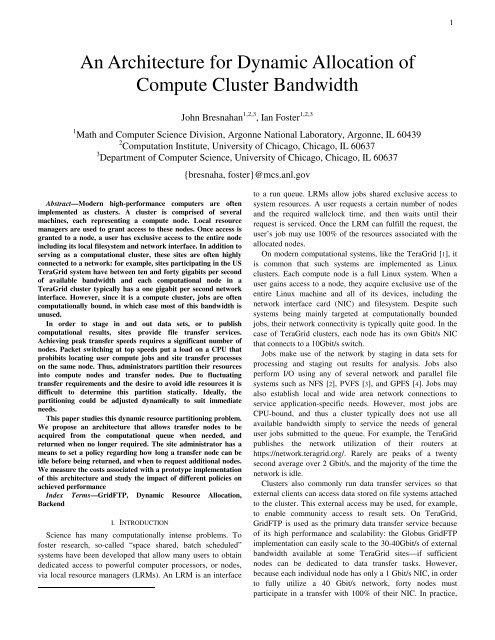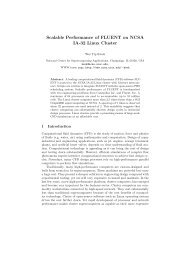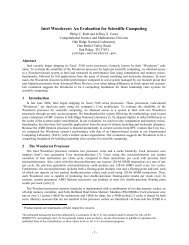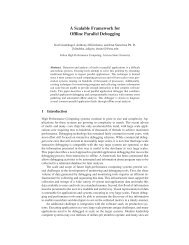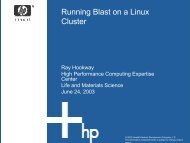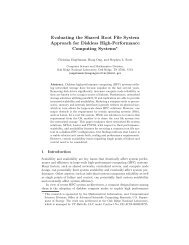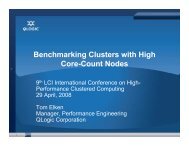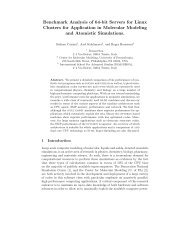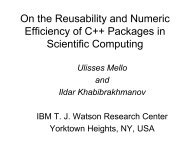An Architecture for Dynamic Allocation of Compute Cluster Bandwidth
An Architecture for Dynamic Allocation of Compute Cluster Bandwidth
An Architecture for Dynamic Allocation of Compute Cluster Bandwidth
Create successful ePaper yourself
Turn your PDF publications into a flip-book with our unique Google optimized e-Paper software.
1<strong>An</strong> <strong>Architecture</strong> <strong>for</strong> <strong>Dynamic</strong> <strong>Allocation</strong> <strong>of</strong><strong>Compute</strong> <strong>Cluster</strong> <strong>Bandwidth</strong>John Bresnahan 1,2,3 , Ian Foster 1,2,31 Math and <strong>Compute</strong>r Science Division, Argonne National Laboratory, Argonne, IL 604392 Computation Institute, University <strong>of</strong> Chicago, Chicago, IL 606373 Department <strong>of</strong> <strong>Compute</strong>r Science, University <strong>of</strong> Chicago, Chicago, IL 60637{bresnaha, foster}@mcs.anl.govAbstract—Modern high-per<strong>for</strong>mance computers are <strong>of</strong>tenimplemented as clusters. A cluster is comprised <strong>of</strong> severalmachines, each representing a compute node. Local resourcemanagers are used to grant access to these nodes. Once access isgranted to a node, a user has exclusive access to the entire nodeincluding its local filesystem and network interface. In addition toserving as a computational cluster, these sites are <strong>of</strong>ten highlyconnected to a network: <strong>for</strong> example, sites participating in the USTeraGrid system have between ten and <strong>for</strong>ty gigabits per second<strong>of</strong> available bandwidth and each computational node in aTeraGrid cluster typically has a one gigabit per second networkinterface. However, since it is a compute cluster, jobs are <strong>of</strong>tencomputationally bound, in which case most <strong>of</strong> this bandwidth isunused.In order to stage in and out data sets, or to publishcomputational results, sites provide file transfer services.Achieving peak transfer speeds requires a significant number <strong>of</strong>nodes. Packet switching at top speeds put a load on a CPU thatprohibits locating user compute jobs and site transfer processeson the same node. Thus, administrators partition their resourcesinto compute nodes and transfer nodes. Due to fluctuatingtransfer requirements and the desire to avoid idle resources it isdifficult to determine this partition statically. Ideally, thepartitioning could be adjusted dynamically to suit immediateneeds.This paper studies this dynamic resource partitioning problem.We propose an architecture that allows transfer nodes to beacquired from the computational queue when needed, andreturned when no longer required. The site administrator has ameans to set a policy regarding how long a transfer node can beidle be<strong>for</strong>e being returned, and when to request additional nodes.We measure the costs associated with a prototype implementation<strong>of</strong> this architecture and study the impact <strong>of</strong> different policies onachieved per<strong>for</strong>manceIndex Terms—GridFTP, <strong>Dynamic</strong> Resource <strong>Allocation</strong>,BackendI. INTRODUCTIONScience has many computationally intense problems. T<strong>of</strong>oster research, so-called “space shared, batch scheduled”systems have been developed that allow many users to obtaindedicated access to powerful computer processors, or nodes,via local resource managers (LRMs). <strong>An</strong> LRM is an interfaceto a run queue. LRMs allow jobs shared exclusive access tosystem resources. A user requests a certain number <strong>of</strong> nodesand the required wallclock time, and then waits until theirrequest is serviced. Once the LRM can fulfill the request, theuser’s job may use 100% <strong>of</strong> the resources associated with theallocated nodes.On modern computational systems, like the TeraGrid [1], itis common that such systems are implemented as Linuxclusters. Each compute node is a full Linux system. When auser gains access to a node, they acquire exclusive use <strong>of</strong> theentire Linux machine and all <strong>of</strong> its devices, including thenetwork interface card (NIC) and filesystem. Despite suchsystems being mainly targeted at computationally boundedjobs, their network connectivity is typically quite good. In thecase <strong>of</strong> TeraGrid clusters, each node has its own Gbit/s NICthat connects to a 10Gbit/s switch.Jobs make use <strong>of</strong> the network by staging in data sets <strong>for</strong>processing and staging out results <strong>for</strong> analysis. Jobs alsoper<strong>for</strong>m I/O using any <strong>of</strong> several network and parallel filesystems such as NFS [2], PVFS [3], and GPFS [4]. Jobs mayalso establish local and wide area network connections toservice application-specific needs. However, most jobs areCPU-bound, and thus a cluster typically does not use allavailable bandwidth simply to service the needs <strong>of</strong> generaluser jobs submitted to the queue. For example, the TeraGridpublishes the network utilization <strong>of</strong> their routers athttps://network.teragrid.org/. Rarely are peaks <strong>of</strong> a twentysecond average over 2 Gbit/s, and the majority <strong>of</strong> the time thenetwork is idle.<strong>Cluster</strong>s also commonly run data transfer services so thatexternal clients can access data stored on file systems attachedto the cluster. This external access may be used, <strong>for</strong> example,to enable community access to result sets. On TeraGrid,GridFTP is used as the primary data transfer service because<strong>of</strong> its high per<strong>for</strong>mance and scalability: the Globus GridFTPimplementation can easily scale to the 30-40Gbit/s <strong>of</strong> externalbandwidth available at some TeraGrid sites—if sufficientnodes can be dedicated to data transfer tasks. However,because each individual node has only a 1 Gbit/s NIC, in orderto fully utilize a 40 Gbit/s network, <strong>for</strong>ty nodes mustparticipate in a transfer with 100% <strong>of</strong> their NIC. In practice,
2sites are reluctant to dedicate that number <strong>of</strong> nodes to datatransfer tasks, given that it is only occasionally that externalclients require this data transfer rate. Thus, innovative uses <strong>of</strong>TeraGrid clusters, such as network replication applications,proxy applications, and transfer applications such as DRS [5]and SQUID [6], cannot be supported.One solution to this problem is to dedicate nodes to the datatransfer service. However, unless the site is constantly in need<strong>of</strong> peak data transfer requirements, some <strong>of</strong> these nodes will beidle. Typically, peak data transfer requirements are short lived.Assuming that the LRM always has some jobs in the wait state(which is typical <strong>for</strong> successful compute sites), this leads to asituation where the site has job requests waiting even thoughthere are idle resources on which they could run. Since theseidle resources could be diverted to servicing computationaljobs, again the wait times are artificially long.<strong>An</strong>other solution is to use a node <strong>for</strong> the data transferservice while that same node is servicing a user’s job.However this approach is also not ideal. On modernprocessors, packet switching at gigabit rates requires asignificant amount <strong>of</strong> the CPU. When any type <strong>of</strong> securityprocessing, like packet signing or encrypting, is used theproblem is greatly exacerbated. On a dual Itanium-64 1.5GHzUC TeraGrid node, we ran transfer tests <strong>for</strong> ten seconds andmeasured the CPU load using some common per<strong>for</strong>mancebenchmarks: iperf [7], globus-url-copy [8], globus-xioperf [9],and netperf [10]. The results are shown in Table 1. In the bestcase, 8% <strong>of</strong> the CPU was used which is a nontrivial amount ifthe user is expecting a dedicated resource. Users who haveacquired nodes from the queue have an expectation <strong>of</strong>exclusive access to the node’s resources, co-locating a highper<strong>for</strong>mance transfer with a user’s job would not only deny theuser network cycles that they may require, but also CPU andmemory bus cycles.Table 1: CPU load imposed by different networkbenchmarksBenchmark CPU Load (%) Transfer Rate (Mbit/s)netperf 8 990iperf 10 990globus-url-copy 13 944globus-xioperf 11 944globus-xioperf (gsi integrity) 79 99globus-xioperf (gsi private) 88 40The correct solution to this data transfer problem, webelieve, is to allow nodes to be transferred dynamically, in anon-demand fashion, between a pool <strong>of</strong> compute resources anda pool <strong>of</strong> data transfer resources. When data transferrequirements increase, nodes can be transferred from thecompute pool to the data transfer pool; when the transfer loaddrops, or perhaps when the compute load increases, nodes canbe returned to the compute pool and again used to servicecomputational requests. In this way, we ensure that there arenever idle resources when job requests (or data requests) waitto be serviced.This paper proposes an architecture that allows such adynamic partitioning <strong>of</strong> transfer nodes and compute nodes. Wepresent an architecture that can work with any standard LRMon a computational cluster. We propose extensions to theGlobus Toolkit(tm) GridFTP server [11] and developimplementation techniques to support this architecture. We usemonitoring interfaces defined by the Web Services ResourceFramework (WSRF) [12] to observe the state <strong>of</strong> thearchitecture in a non-disruptive and modular way, and allowsite administrators to set policies controlling the partitions in amodular fashion. We per<strong>for</strong>mance test a prototype system todetermine costs associated with our approach.II. RELATED WORKWe review work that has overlapping concepts and solvessimilar problems to that <strong>of</strong> dynamic allocation <strong>of</strong> computecluster bandwidth. The majority <strong>of</strong> such work focuses onstorage space or CPU scavenging. We also look at concepts inqueuing theory. Because we are allocating resources to userrequests there is overlap with queuing research. Additionallywe review work regarding load predictions <strong>for</strong> both networktransfers and computational jobs.Shadan et al., in their paper “<strong>Dynamic</strong> Mirroring <strong>for</strong>Efficient Web Server Per<strong>for</strong>mance Management” [13], proposea solution <strong>for</strong> dynamically mirroring <strong>of</strong> web servers. In theirapproach, they have a set <strong>of</strong> cooperative web servers. As themain server’s load gets unacceptably high, they transfer someportion <strong>of</strong> the data to a selected mirror site. This workintroduces interesting concepts <strong>for</strong> WAN replication, but thatis not the goal <strong>of</strong> our research. In our work we decouple atransfer resource from a storage resource. Further, they assumea static set <strong>of</strong> mirror servers and do not allow <strong>for</strong> a growingand shrinking pool <strong>of</strong> resources, which is an important part <strong>of</strong>our work.Freeloader [14] is a distributed storage scavenging system. Ittakes advantage <strong>of</strong> unused desktop storage and availablebandwidth to create a distributed storage cache <strong>for</strong> read onlydata. Freeloader asserts that desktop machines do not have thestorage capacity to store large scientific data sets on local diskin their entirety, yet at the same time at least half <strong>of</strong> the localdisk is typically empty. Its goal is to harness all empty diskspace at a site into a single data cache with little additionalexpense. The work we present here shares the ideas <strong>of</strong>reclaiming idle bandwidth, and the idea <strong>of</strong> providingadditional I/O power at little additional cost to the site;however we are not investigating storage systems. Our focus ison high utilization <strong>of</strong> network resources.Domain Name Service (DNS) has a load balancing feature.It can be used to share host load by mapping server physicalmachines to the same domain name. Clients send the DNS adomain name, and the DNS returns to them an IP address.
3When DNS-Round-Robin is in place, several IP addresses aremapped to the same domain name. The IP address that theDNS chooses to respond with is selected in a round robinfashion. While effectively distributing the physical machines towhich a client connects, it does not distribute load. A clientmay lookup a server and not use it <strong>for</strong> a transfer, in which casesome servers will be used <strong>for</strong> transfers more <strong>of</strong>ten than others.In our approach we only seek out a transfer node when wehave a transfer request, there<strong>for</strong>e we have a good idea <strong>of</strong> theload it will incur. More importantly, the DNS approach doesnot take into account sharing <strong>of</strong> computational and transferresources in a dynamically changing environment.Our work overlaps with concepts prevalent in queuingtheory. We are allocating resources to support a user loadwhich is the fundamental problem that queues are designed tosolve. Our work is not researching into the field <strong>of</strong> queuingtheory. We are rather acting as a user <strong>of</strong> it from a layer above.However, it is important <strong>for</strong> us to understand how we areaffected by some <strong>of</strong> its fundamental concepts. Additionally,ongoing work in this field will allow some importantextensions to the architecture we propose here.The backfill algorithms described in “Core Algorithms <strong>of</strong>the MAUI Scheduler” [15] and "Utilization, Predictability,Workloads, and User Runtime Estimates in Scheduling theIBM SP2 with Backfilling" [16] play a role in node acquisition<strong>for</strong> our system. The proposed architecture will per<strong>for</strong>m bestwhen nodes can be obtained quickly. Further, most transferjobs run <strong>for</strong> a relatively short amount <strong>of</strong> time. These twocharacteristics dovetail well into backfill. A queue maintains alist <strong>of</strong> jobs that it orders according to priority. To preventstarvation, the order in which the jobs are requested plays astrong role in this priority. The scheduler then matches jobswith nodes. Higher priority jobs receiver earlier start times.Since requests vary in wallclock time and number <strong>of</strong> nodesrequired, the process inevitably leaves time gaps between jobs.Backfilling searches the remaining lower priority job to findthose that can fit into these time gaps. This can result in lowerpriority jobs running be<strong>for</strong>e higher priority jobs, but it does notdelay any job from its originally scheduled time, it simply useswhat would otherwise be idle time. Naturally jobs whichrequest a small number <strong>of</strong> nodes and a short wallclock time areable to fit into the most gaps and thus have a higher likelihood<strong>of</strong> running at an earlier time. Our architecture takes advantage<strong>of</strong> this by always requesting the smallest number <strong>of</strong> nodes, anda relatively short wallclock time.There has been much research on predicting resource loadrequirements [17] [18] [19], including network loads [20] [21][22]. Our system can benefit from this work. If we were able topredict network loads quickly and accurately enough, we couldset resources aside ahead <strong>of</strong> time <strong>for</strong> network traffic spikes. Toallow <strong>for</strong> this possibility, we have designed into ourarchitecture a way <strong>for</strong> prediction algorithms to be implementedin a natural and modular fashion. We discuss this topic whenwe introduce the controller program.Fast access to nodes is one challenge that our architecturefaces. We cannot instantly obtain a node because a user’s jobmay be running on it. There<strong>for</strong>e we must wait <strong>for</strong> a job tocomplete be<strong>for</strong>e the scheduler will even consider grantingaccess to our system. Ideally we could suspend any runningjob, use its node <strong>for</strong> a transfer, and then restart that user’s jobwhen we are finished, all without disrupting the job or denyingit wallclock time. Research into virtual machines [23] can beused to achieve this. By running each job in a virtual machinethe entire system state can be suspended and even migrated toanother host. As this research advances we expect it to providesolutions <strong>for</strong> immediate node access.III. ARCHITECTURERecall that our goal is to define an architecture which allowswell connected computational clusters to service bandwidthgreedy applications without incurring the cost <strong>of</strong> dedicatedresources. We propose a modular architecture that uses asmany existing components as possible. Monitoring s<strong>of</strong>tware isused to observe the state <strong>of</strong> the stock components and provideenough in<strong>for</strong>mation so that policy decisions can be made in aseparate and noninvasive process. Our architecture defines thefollowing components:Nodes: Nodes are full computer systems complete with theiroperating system, CPU, memory, disk and NIC. A typicalexample is a PC running Linux. Nodes are used <strong>for</strong> servicinguser requests. They must be appropriate <strong>for</strong> both computationand transfer with fast NICs (e.g., gigabit Ethernet cards) andfast modern CPUs. Nodes should have access to a shared filesystem. This is a common description <strong>for</strong> most computationalclusters, as on the TeraGrid.LRM: <strong>An</strong> admission control queue that has its own means<strong>for</strong> setting policy <strong>for</strong> granting access to nodes. The ability toset high priority in order to preempt jobs that have waitedlonger in the queue, and the ability to suspend running jobs areimportant features but not mandatory. Common examples <strong>of</strong>such LRMs are PBS [24], LSF [25], MAUI, and LoadLeveler[26]. A GRAM [27] interface to the LRM is recommended.Transfer Service: This is the component responsible <strong>for</strong>transferring data in and out <strong>of</strong> the cluster. The transfer servicecomprises a frontend service and a set <strong>of</strong> backend services.The frontend service acts as a contact point <strong>for</strong> clients, and asa load balancing proxy to the backend services which move thedata. Backend services run on nodes acquired from the LRM.The frontend must be instrumented with monitoring s<strong>of</strong>twareso that an external process can observe its state to makedecisions based upon the load.Controller: This component is the brain <strong>of</strong> the system. Itobserves the frontend transfer service to determine when clientload is high or when the backend transfer node pool is idle, atwhich point it interacts with the LRM to either acquire a newnode <strong>for</strong> use in data transfer or release an idle node from thetransfer pool back into the computational queue. Thecontroller’s decisions are based upon a policy set by the siteadministrator.
4Figure 1 shows how these components interact. Clientscontact the frontend transfer service with transfer requests. Thefrontend goes to the transfer node pool to find an availablebackend service. The backend service with the lowest load isselected to per<strong>for</strong>m the transfer. If there is no availablebackend service, or all are too busy, the frontend waits <strong>for</strong>some amount <strong>of</strong> time and then asks again. The client is stalledon this process but is free to timeout without disturbing thesystem.The controller observes the state <strong>of</strong> the frontend service.When the client load exceeds the available resources in thetransfer pool, the controller requests a new backend servicefrom the LRM. The faster this request can be serviced, thebetter the overall system’s per<strong>for</strong>mance. Ideally, the controllerwould have special privileges allowing it to acquire nodesimmediately, <strong>for</strong> example by suspending current user jobs orpreempting other jobs that have waited longer. Typicallytransfers do not require large amounts <strong>of</strong> time so nodesacquired in this way could be returned to the compute poolquickly.specifically requesting use <strong>of</strong> its backend service. Once thatbackend service has worked its way through the LRM’s waitqueue, the frontend will select it and the client’s transfer willbegin.This feature allows the site to directly harness clientknowledge. The clients know what transfer load they require.In this way they ask <strong>for</strong> resources directly from the LRM,there<strong>for</strong>e they gain access to transfer nodes in a fair andmanaged way. Further they maintain all <strong>of</strong> the conveniences <strong>of</strong>a standard transfer service interface because they are notrequired to stand up their own custom transfer services. If theuser needs specific resources and times dedicated to theirtransfer they can arrange advanced reservations [28] in thesame familiar manner as they would <strong>for</strong> any compute job.Further most LRMs have mechanisms to provide approximatestart times. This can be useful in<strong>for</strong>mation to transferapplications that need resource guarantees. This featureeffectively provides a mechanism <strong>for</strong> scheduling data transfers.By running backend services directly from the LRM, instead<strong>of</strong> via an intermediate provisioning service (like the frontendand controller) all <strong>of</strong> the features <strong>of</strong> the LRM can beleveraged. Scheduling the transfer with fair sharing to siteresources is then controlled in a more appropriate place, as isload prediction and security audit trails.Figure 1: Component InteractionIn the absence <strong>of</strong>, or in addition to, special rights to thequeue, the controller program can implement “caching” orretention policies, meaning that it holds nodes <strong>for</strong> some timebe<strong>for</strong>e returning them. Similarly, “prefetching” policies can beimplemented that attempt to ensure that there are always idletransfer nodes available: as resources in the transfer pool areconsumed, additional nodes can be requested from the LRM.More sophisticated logic can also be implemented: <strong>for</strong>example, we might observe the state <strong>of</strong> the frontend serviceover a long time and make assumptions and predictions aboutclient load spikes. The controller can also access log files anddatabases at the administrator's discretion. The optimalpolicies may be site specific, so it is crucial to the architecturethat the administrators have a means to set sophisticated policyin ways suited to their specific needs.The architecture provides another important source <strong>of</strong>flexibility. A client can interact directly with both the LRMand the frontend service. Using their own credentials andsubmission rights clients can request the same standardbackend service that the controller requests from the LRM.The client can then request a transfer from the frontend serviceIV. IMPLEMENTATION DETAILSOur proposed architecture allows a site to use any LRM andnode configuration that it already has in place. Our goal is toprovide existing computational sites with insight into how theycan better leverage their available bandwidth. <strong>An</strong> importantsubgoal is to be minimally disruptive to the existing system.The only new components that we require to implement thisarchitecture are the transfer service and the controller.A. Transfer ServiceFor the transfer service we use the GridFTP server releasedwith the Globus Toolkit [29]. This versatile piece <strong>of</strong> s<strong>of</strong>twarecan be configured to run in a variety <strong>of</strong> modes [30]. For thispaper we used the separation <strong>of</strong> processes mode, which meansessentially that we configure it as a proxy server. A frontendservice acts as the contact point <strong>for</strong> clients wishing to initiatedata transfers; this service does not do any <strong>of</strong> the actualtransporting <strong>of</strong> data. The actual shipping <strong>of</strong> bits is left to thebackend services. The frontend and backend servicescommunicate with each other via an internal protocol(typically over a LAN), which allows processes to be ondifferent machines. The backend services are workers <strong>for</strong> thefrontend and per<strong>for</strong>m operations as they are directed.
6created from the WSDL which makes client interaction withthe service as easy as making a local function call. Morein<strong>for</strong>mation on WS C and WSRF can be found in the WS CCore web pages [36] and in “The <strong>An</strong>atomy <strong>of</strong> the Grid:Enabling Scalable Virtual Organizations,” [37].E. The Embedded ServiceWe identify the following list <strong>of</strong> internal state the frontendservice must expose to the controller:• Current client connections: The number <strong>of</strong> clientscurrently requesting or per<strong>for</strong>ming transfers.• Max client connections: The maximum number <strong>of</strong> clientsallowed to connect simultaneously.• Available Backend Services: The number <strong>of</strong> backendservices ready <strong>for</strong> use.• Approximate load <strong>of</strong> each backend: a percentageassociated with each backend that approximates how hard it isworking.We defined these states in a WSRF compliant WSDLdocument as resource properties. The WSDL documentsserves as an interface definition <strong>for</strong> both clients and services.We use it to generate stubs <strong>for</strong> the controller programs andalso to create a service <strong>for</strong> exposing these resource properties.Because it is important <strong>for</strong> the service to be light weight andhave very low overhead interactions with the frontend servicewe used WS C Core.WS C Core is a light weight hosting environment that canbe embedded into the GridFTP frontend service. WS C Corecompiles to native code allowing it to be linked into existingapplications. From the WSDL we generate C bindings whichhandle the conversion <strong>of</strong> SOAP messages into C datastructures. Using the bindings we create an embeddableservice that observes the internal state <strong>of</strong> the GridFTP serverand sets the resource properties appropriately as the statechanges. The service is linked into a shared library which isloaded at runtime in the presence <strong>of</strong> an option. If loaded, theWS service starts providing in<strong>for</strong>mation; if not loaded, theGridFTP server is left entirely unaffected.F. ControllerThe controller is a client to the embedded service. ViaWSRF, it gets notifications from the frontend service whenany <strong>of</strong> the resource properties defined above change. Stubs aregenerated from the WSDL that make each notification asimple function call. When a client connects or disconnects, orwhen a backend is added or removed from the transfer pool, orwhen the frontend service’s exposed state otherwise changes,the controller is notified asynchronously. It then uses thisin<strong>for</strong>mation to decide when to start new backend serviceinstances and when to kill existing ones.The controller also observes the amount <strong>of</strong> time that anybackend is idle and may, depending on the policy that itimplements, decide to kill the backend service so that theassociated node can be returned to the compute resource pool.The GridFTP server is fault tolerant and can handleunexpected backend service termination. Termination <strong>of</strong> onebackend has no effect on any other, nor does it affect thefrontend service. However, it may leave a client that requesteda transfer with an error. Such errors are not a problem sinceGridFTP transfers can be restarted in such a way that little dataneeds retransmission.The controller uses GRAM to start up new backend serviceinstances via the LRM. GRAM is used because it is aconvenient and easy to use interface to many different LRMs.The ease <strong>of</strong> use is important <strong>for</strong> enabling the creation <strong>of</strong> sitespecific policies. With GRAM starting up a new backend is asimple function call available in many programminglanguages. Additionally GRAM is a network protocol whichallows the controller to run on an entirely separate system fromthat <strong>of</strong> the LRM. No CPU cycles or other resources arediverted from the frontend and thus we can expect that theper<strong>for</strong>mance <strong>of</strong> the transfer service will be minimally affected.Figure 3: Event SequenceFigure 3 shows the event sequence <strong>of</strong> our architecture. Aclient connects to the frontend service and requests a transfer(line 1). If an unused backend service instance has alreadybeen registered with the frontend service it is used, if not thefrontend waits <strong>for</strong> one to be registered. The controller receivesa WSRF notification when the client connects telling it that thestate <strong>of</strong> the frontend service has changed (line 2). Thecontroller may then use the GRAM interface to the LRM tostart up a new instance <strong>of</strong> a backend service (line 3). Thenewly requested backend service will not start immediately,and the time it takes to start will vary with contention in theLRM’s wait queue. When it does start, it registers itself withthe frontend service (line 5). The frontend service can now useit and the clients can begin transferring data (line 6).The decision as to when to start up a new backend serviceinstance is entirely up to the logic <strong>of</strong> the controller. In somecases the controller will wait until a client request prompts theneed <strong>for</strong> a new backend. In other cases it may start a newinstance based on a prediction algorithm guessing that atransfer request will be made in the near future. Its modularplacement in the architecture allows it to be noninvasive to the
7rest <strong>of</strong> the system. It simply observes the running state andinjects new resources when its policy allows.V. EXPERIMENTAL STUDIESTo establish a pro<strong>of</strong> <strong>of</strong> concept <strong>for</strong> this architecture wedeveloped a prototype system. We implemented allmodifications to the GridFTP server specified above. Wecreated controllers to implement some basic policies,described in detail below. All tests were run using theUniversity <strong>of</strong> Chicago TeraGrid system, in which each nodehas a 1.5GHz Dual Itanium processor, 4 GByte RAM andGbit/s Ethernet. We use globus-url-copy as the client to thetransfer service in all <strong>of</strong> our experiments.A. Simple LRMThe University <strong>of</strong> Chicago TeraGrid system operates a PBSLRM with which our prototype can interact. However, thecluster is generally well used and the wait times <strong>for</strong> nodes canbe high. As this wait time is entirely dependent on outsidevariables, we could not use it in controlled experiments. Toaddress this problem, we implemented our own simple LRM<strong>for</strong> the purposes <strong>of</strong> experimentation. We then simulated acompute cluster by leasing TeraGrid nodes from PBS andusing those nodes <strong>for</strong> our own purposes within our simulatedLRM.We acquire one node from PBS to be the service provider.On it we run the GridFTP frontend service, the controller, theGRAM service, and the simple LRM. <strong>An</strong> additional set <strong>of</strong>nodes is acquired and designated as the compute/transfernodes <strong>for</strong> our simple cluster. One interface to the queue is ascript to be passed to the command line <strong>of</strong> the job to remotelyrun. The node on which the user job will be executed is chosenvia round robin selection. The job is then remotely executedon that machine via ssh [38]. In order to simulate the nontrivialqueue traversal time that is typically encountered in queuingsystems, the script will sleep be<strong>for</strong>e remotely starting theuser’s job. The sleep time is set in a configuration file that canbe changed dynamically.In addition to providing direct access to our simple LRM bycalling the submission script, we also provide a GRAMinterface. The GRAM ManagedJobFactoryService is designedto be configured to interact with a variety <strong>of</strong> LRMs, includingLSF, PBS, and others. We extended it to run against oursimple LRM as well. This way all <strong>of</strong> the XML messagingoverhead to the simple queue is the same as it would be to anyother queue. The only difference is the remote execution viassh versus the proprietary mechanisms used by the specificLRM.B. PoliciesWe evaluate our prototype system using four differentpolicies, which we now describe. Many other policies can beimagined (and can be implemented in our architecture); wechoose these policies to provide insight into the efficiency andapplicability <strong>of</strong> the architecture.1) Zero IdleThe zero idle policy does not allow a backend node to beidle <strong>for</strong> any time. Thus, nodes can neither be pre-fetched norcached. Each time a client connects to the frontend service andrequests a transfer, a request <strong>for</strong> a new backend serviceinstance is submitted to the LRM. When the transfer completesthe backend service immediately ends and the node it wasrunning on is released to the LRM <strong>for</strong> use in scheduling otherjobs. When using this policy, the amount <strong>of</strong> time it takes tostart a transfer is entirely dependent upon the wait time <strong>of</strong> theLRM and amount <strong>of</strong> time it takes <strong>for</strong> the notification to reachthe controller.2) Infinite IdleThe infinite idle policy is the exact opposite <strong>of</strong> the zero idlepolicy in terms <strong>of</strong> how it handles idle backend services. A set<strong>of</strong> backend service instances are started in advance and addedto the transfer pool. They are allowed to be idle <strong>for</strong> the lifetime<strong>of</strong> the frontend service and there<strong>for</strong>e the nodes on which theyrun are never returned to the computational pool. With thispolicy there will be idle backend services ready to handle aclient request at all times, until the system reaches maximumcapacity.3) N-IdleThe N-Idle policy is a simple approach to prefetching andcaching backend transfer nodes. The policy attempts to have Nbackend services idle at all times. When the system starts up,N backend services are created. These backend services areidle until a transfer is requested. When the transfer is requestedone <strong>of</strong> the N backend services is immediately allocated toservice the transfer request. Since there are now N – 1 idlebackend services, the controller implementing this policyrequests the creation <strong>of</strong> a new backend service in an attempt tomaintain N. Since creation <strong>of</strong> a new backend service takestime, there will not always be N idle, however the sum <strong>of</strong> idleand requested backend services will always equal N.4) Time CacheThe Time Cache policy allows a backend service to continuerunning and servicing transfer requests <strong>for</strong> the entire wallclockduration. Unlike the Zero Idle policy which returns the node tothe LRM immediately upon completion <strong>of</strong> its first and onlytransfer request, the Time Cache policy will continue to wait<strong>for</strong> additional transfer requests until its lease from the LRMtimes out. The assumption is that the time and ef<strong>for</strong>t requiredto obtain a node from the LRM is greater than that <strong>of</strong> a singletransfer and thus it is worth caching <strong>for</strong> its wallclock time. Themaximum amount <strong>of</strong> idle time is never greater than thewallclock time.The first two policies represent two extremes. Infinite idlerepresents an optimal policy from the perspective <strong>of</strong>connection time. Backend services are always ready, and soour architecture adds no additional overhead. Infinite idle isequivalent to the GridFTP proxy server without ourmodifications, with backend services statically assigned to afrontend and always available to it. In contrast, zero idleprovides the worst case scenario <strong>for</strong> connection time. Since
8backend services must be created <strong>for</strong> every transfer request,the maximum amount <strong>of</strong> latency is added to every connection.Conversely, since backend services are never idle, zero idleprovides the best possible case when minimizing idle transferresources, and infinite idle is the worst possible case. Thesetwo policies are base cases <strong>for</strong> evaluating the architecture.The N-idle policy is a hybrid <strong>of</strong> zero-idle and infinite-idle. Itattempts to optimize connection times by having backendservices immediately available <strong>for</strong> transfers while at the sametime putting an upper bound on idle resources. While thenumber <strong>of</strong> idle backend services is bounded, the number <strong>of</strong>working nodes is not, and thus the policy can scale up tosupport high transfer loads. Because the value <strong>of</strong> N isconfigurable, the site administrator can decide on anappropriate balance between idle resources and lowconnection times.Administrators may want more sophisticated policies toaddress specific needs. Our architecture provides access toin<strong>for</strong>mation that allows arbitrarily complex policies to bedefined, based on intimate knowledge <strong>of</strong> the transfer serviceand a site’s history. We leave the exploration <strong>of</strong> such policies<strong>for</strong> future work.C. MetricsWe use three criteria to evaluate the system: site bandwidthutilization, connection time, and user bandwidth. The mostimportant metric is site bandwidth utilization. Our main goal indefining this architecture is to use idle network cycles. If wecan provide transfer services with access to large amounts <strong>of</strong>bandwidth, we believe existing applications will make use <strong>of</strong> itand additional use cases will be discovered, and thus we aresuccessful. In our experiments we measure bandwidth byrunning daemons on the client machines. These daemons readthe raw network usage from the Linux /proc filesystem [39]and use that in<strong>for</strong>mation to track the number <strong>of</strong> bytes themachine has transferred over the life time <strong>of</strong> our experiments.We take samples every second and then post process theresults to calculate bandwidth over the experiments timeinterval. Because only our jobs are running on the clientmachines we know the bytes transferred are a result <strong>of</strong> ourexperiments. Our goal is to utilize all available bandwidth sowe must count bytes sent under the IP protocol stack. We arenot measuring end to end throughput. If resends are needed byTCP due to packed loss we count the resends as additionalbytes. Our results would otherwise appear to have used lessnetwork resources than were actually used. This issue has verylittle effect because all experiments are done on an underutilized LAN where packet loss is infrequent.The second metric is connection time. We define connectiontime as the latency from when a client first connects to thetransfer service until the time the transfer begins. Be<strong>for</strong>e atransfer can begin the frontend must find an available backendservice. In the worst case, this time will include the latency <strong>of</strong>the WSRF notification message updating the controller that thefrontend services state changed, the entire length <strong>of</strong> the LRM’swait queue, and the latency <strong>of</strong> the backend service request tothe LRM. This time has the potential to be high and could havea significant effect on overall system throughput. Further,while this architecture is targeted at batch transfers, sites maywish to support interactive transfer services as well, in whichcase connection times need to be low. We measure theconnection time with a plug in to globus-url-copy. The timeinterval begins immediately be<strong>for</strong>e the TCP connect functionis called, and ends when FTP login message “230 User loggedin” [40] is received.The last metric is achieved user bandwidth. Our goal is toprovide a transfer service that can exploit large amounts <strong>of</strong> idlenetwork cycles. In order <strong>for</strong> this service to be useful, we musthave applications that wish to use it. To make the serviceattractive to applications we must be able to service eachtransfer request with enough bandwidth to satisfy its needs.How much bandwidth is needed is a subjective measure.Ideally the application would be the bottleneck in the transferand not the transfer service. As 100 Mbit/s Ethernet cardsbecome outdated and Gbit/s Ethernet cards become standard,even on laptops, we aim to provide near Gbit/s transfers toclients.VI. RESULTSWe present results <strong>for</strong> five sets <strong>of</strong> experiments using oursimple LRM. The first experiment evaluates the validity <strong>of</strong> theLRM we used by comparing it to the PBS system used on theUC TeraGrid. We then measure the connection time as afunction <strong>of</strong> increasingly heavy loads. This experiment isdesigned to analyze the overhead introduced by our system.We similarly measure the connection time to see how the LRMwait queue times affect it. Following this we measure how ourvarious policies behave under lighter, and more naturallyoccurring, client loads. The final experiment shows thebandwidth that our system can consume and the throughput itcan deliver to individual clients.In all experiments we took care to prevent any one iteration<strong>of</strong> tests from affecting the next iteration. For the zero idle andinfinite idle policies this is not a problem. Those two basicpolicies are not affected by previous client access patterns.However, the n idle policy can be greatly affected by previousaccess patterns. If a previous test is still holding a backendservice, or if the backend service that was started to replace aused backend service has not yet begun, our results could becorrupted. To protect against this, we verified that the systemwas in a stable state be<strong>for</strong>e running any iteration <strong>of</strong> our tests.When one test finished we waited <strong>for</strong> all resources associatedwith previous transfers to be cleaned up and <strong>for</strong> all requestedbacked services to start be<strong>for</strong>e we began the next iteration <strong>of</strong>tests.A. Simple LRM ValidationOur first results validate our simple queuing system. Sincewe intend that our architecture work with standard and widelyused LRMs such as PBS, we must show that our systemprovides a reasonable approximation <strong>of</strong> the behavior <strong>of</strong> astandard system like PBS. The difference in which we are
1the controller can get immediate access to a node bypreempting or suspending other jobs, then the queue wait timeis no longer relevant. While preemption can be handled withhigh priorities, and backfilling can allow faster access to thequeue <strong>for</strong> short running jobs <strong>of</strong> this nature, it may not provideimmediate access. Suspending running jobs can provideimmediate access; however this is a complicated issue andtypically requires virtual machines. Since this is not alwayspossible, we use pre-fetching and caching <strong>of</strong> backend services.the effects <strong>of</strong> the n-idle and zero idle policies under lighterclient loads.Figure 5: The Effect <strong>of</strong> Load on Connect TimeWe per<strong>for</strong>m the same study using the N-Idle policy and setN=4. Figure 6 shows the results. The Connect time <strong>for</strong> up t<strong>of</strong>our simultaneous clients is low, no matter what the wait time<strong>of</strong> the queue. As the number <strong>of</strong> clients connecting exceeds thevalue <strong>of</strong> N, the connection time increases similarly to the zeroidlepolicy yet remains lower on average due to theimmediately available backends servicing up to N requests.Figure 6: Connection Time <strong>for</strong> Various Waits1) Lighter LoadsMany clients connecting at the exact same time constitutes aheavy load on the system. In practice this situation willtypically not occur: there will be some spacing <strong>of</strong> clientrequests and thus a lower load. In this experiment we measureFigure 7: Lighter LoadsFigure 7 shows the results <strong>of</strong> an experiment in which we runvarious client loads against both the zero idle policy and theN=4-idle policy. The graph shows the connection time as afunction <strong>of</strong> the delay between client requests. The zero-idlepolicy maintains a steady delay that is equal to the backendservice start time. The N-idle connection times start <strong>of</strong>f highbecause the system is overloaded; however they drop <strong>of</strong>fquickly as the interval between requests increases. As requestsare spaced out enough they allow enough time <strong>for</strong> previousrequests to finish be<strong>for</strong>e the next starts. Recall that the time ittakes to finish a request involves the time through the waitqueue as well as the transfer time. With the N-Idle policy N <strong>of</strong>the requests can be serviced immediately and thus finish veryquickly. Once finished the backend service’s node is returnedto the LRM’s compute pool. The backend service that wasstarted to replace the consumed backend will not be ready untilit works its way through the wait queue.The point at which the connection time drops significantlyin this case is seven seconds between transfers. The zero-idleline shows that the node access time is slightly below 30seconds. With seven seconds between transfers and four prefetchednodes the system has 7*4 = 28 seconds to acquire anode be<strong>for</strong>e a new client will be stalled waiting <strong>for</strong> it. Thisresults in the following <strong>for</strong>mula:N = queue wait time / time between clientsNetwork load prediction research can be used here todetermine a value <strong>for</strong> N dynamically as the system runs basedon the expected time between transfer requests.Instead <strong>of</strong> looking at the results to find an ideal value <strong>for</strong> Nwe can alternatively look at the ideal time between transferrequests. If client connection requests are intercepted andspaced far enough apart, the overall connection time couldimprove <strong>for</strong> short transfer times or <strong>for</strong> bursts in client transferrequests. This leaves interesting open questions relating totransfer time prediction. We leave this <strong>for</strong> future work.
1D. ThroughputAs stated, the goal <strong>of</strong> this proposed architecture is tomaximize bandwidth usage <strong>for</strong> batch data transfers. The delaytime to the start <strong>of</strong> the transfer is secondary to maximizingutilization <strong>of</strong> available bandwidth. However, the wait time toacquire a node can affect the overall system throughput. Figure8 shows this.Figure 8: Single Client ThroughputIn the experiment we used the Zero-Idle GRAM policy andrepeatedly ran a single client transfer request <strong>of</strong> a 1 GByte file,one hundred times in sequence. We measured the overallthroughput used by the system as a function <strong>of</strong> an increasingqueue wait times. The maximum possible bandwidth available<strong>for</strong> consumption is one Gbit/s. Our results show that we onlyachieve 20% <strong>of</strong> the maximum with no wait, and as the waittime increases the bandwidth utilization decreases. Thehistograms in Figure 9 provide insight into why. Peak transferrates are reached only over the small interval after a backendservice is allocated to a transfer and be<strong>for</strong>e the transfer isfinished. The peak times are followed by idle intervalsspanning the wait time plus the connection time. The longerthe wait time, the longer the network idle time and thus thelower overall throughput.E. CachingOne approach to eliminating the time gaps between transfersinvolves using the Time Cache policy. We demonstrate thiswith an experiment using four backends and four clientmachines. A client is run on each machine transferring a series<strong>of</strong> one Gigabyte files in serial. Each backend service has awallclock time <strong>of</strong> one minute.Figure 9: Single Client Transfer HistogramsThe graph in Figure 10 shows the results <strong>of</strong> the first 60seconds <strong>of</strong> this experiment. Each colored bar represents thethrough put achieved by a client machine in a two secondstime step. Figure 10 shows the network is only idle at thebeginning when we are requesting new nodes. The remainder<strong>of</strong> the time the backend services are cached and there<strong>for</strong>eready to per<strong>for</strong>m transfer requests immediately. Were theexperiment to continue on <strong>for</strong> another minute we would seeanother drop in per<strong>for</strong>mance as the cached backends wallclocktime expired. This ratio <strong>of</strong> cached time to fetch time can beadjusted by requesting longer and shorter wallclock times.Longer wallclock times will result in higher overall bandwidthutilization under heavy client loads. Conversely, shorterwallclock times reduce the potential backend idle time underlightclientloads.
1Figure 10: Time Cached <strong>Bandwidth</strong>The results <strong>of</strong> this experiment show that our architectureper<strong>for</strong>ms well according to the bandwidth utilization metric asit can scale up to network speeds. Figure 10 also shows howthe architecture is measured against the final metric <strong>of</strong>achieved user throughput. Each client receives transfer rates <strong>of</strong>near gigabit speeds which is the maximum available to it.VII. CONCLUSIONS AND FUTURE WORKWe have designed and implemented an architecture thatallows computational sites to allocate transfer nodesdynamically in response to client request load. A site can usethis architecture to utilize more <strong>of</strong> its network resourceswithout leaving compute nodes idle. By providing a transferservice with a significant amount <strong>of</strong> available bandwidth, sitescan better service their communities and increase their userbase. Further, causing a glut <strong>of</strong> useable network cycles canenable existing and future higher level applications to takeadvantage <strong>of</strong> them. We envision this work as a launching pad<strong>for</strong> research into such applications.The majority <strong>of</strong> related work in this area focuses on storagesystem scavenging. <strong>Bandwidth</strong> usage is a part <strong>of</strong> a distributedstorage system but when the focus is on the storage as opposedto the bandwidth itself different attributes get accentuated. Ourgoal is to focus strictly on idle bandwidth cycles to enablepresent and future applications that move data sets aroundeffectively, making the network itself a storage system orcapitalize on it <strong>for</strong> efficient replication. By providing a servicewith a scheduled interface to predictable amounts <strong>of</strong>bandwidth we can enable an array <strong>of</strong> applications. Someexamples include:• Fast Write Services: <strong>An</strong> application may need to get dataout <strong>of</strong> its memory buffers as quickly as possible so that moredata can be brought in <strong>for</strong> processing. The application may ormay not care about the location the final storage point <strong>of</strong> thedata, because its primary focus is on writing the data towhatever sink can receive it the fastest. If the fastest endpointis not the final endpoint, an out-<strong>of</strong>-band service can later moveit to its final destination.• Replica Services: It can be advantageous to have multiplecopies <strong>of</strong> datasets. Replicas not only provide redundancy incase <strong>of</strong> loss but can also assist with load balancing and transferoptimization. Clients looking to read data can be directed toany replica, thus lightening the load on other sources. Clientscan also gain per<strong>for</strong>mance increases by reading different parts<strong>of</strong> the data from multiple replica locations. Applications thatprovide these replica services could use the bandwidth weprovide as another point <strong>of</strong> replication.• Co-scheduling: The architecture allows <strong>for</strong> users tosubmit backend jobs directly to the LRM. This is an importantaspect <strong>of</strong> this architecture that warrants additional comment.This was not directly studied in the experimental studiessection largely because its per<strong>for</strong>mance is tied to that <strong>of</strong> therun queue and its value is not in connection time or transfertime but rather in the provided scheduling in<strong>for</strong>mation. Byallowing users to start their own backends we give them all theresources and features <strong>of</strong> the LRM. This includes most notablystart time prediction and notification. Further, once thebackend starts it will have an entire dedicated resource with apredictable portion <strong>of</strong> the sites bandwidth. With thisin<strong>for</strong>mation applications can begin to co-schedule [41] bothsides <strong>of</strong> the transfer.Our prototype evaluation has shown that this system can beeffective. It takes advantage <strong>of</strong> otherwise idle network cyclewithout causing unnecessary delays to the compute wait queue.When faced with heavy client loads our system candynamically scale up to peak client transfer demands andrelease the resources as the load decreases.While our system is targeted at batch transfers, <strong>for</strong> whichconnection time is less crucial, our evaluation shows that thearchitecture can provided a reasonable interactive serviceunder moderate client loads. We achieve this per<strong>for</strong>mance bypre-fetching nodes and/or caching nodes by allowing them toremain idle after completing transfers and be<strong>for</strong>e new transfersstart. Idle resources do unnecessarily detract from the computequeue but we have show how to put limits on the amount <strong>of</strong>idle resources without preventing the system from scaling upunder heavier loads.For batch transfers we have shown that the system can scaleup to high levels <strong>of</strong> network utilization. Since we used thezero-idle policy in our experiments the high bandwidthutilization that we achieved did not come at the expense <strong>of</strong> idlecomputer resources. While we did divert resource from the runqueue <strong>for</strong> transfers we did not leave them idle.In the future we would like to study the effects <strong>of</strong> a steadypulsing <strong>of</strong> clients in more detail. As we found in our evaluation<strong>of</strong> the n-idle policy, when client transfer requests are spacedout over time, the connect times drop significantly. We wouldlike to explore specifically how and why this happens. It ispossible that we could intercept client requests be<strong>for</strong>e sendingthem to the GridFTP frontend service, and then allowconnections only at regular intervals using token bucket orsome similar algorithm. While this strategy would impose adelay on the connection time, the delay may be low, regular,
[31] 31 I. Foster, C. Kesselman, G. Tsudik, and S. Tuecke, “A Security<strong>Architecture</strong> For Computational Grids,” in 5th ACM Conference on<strong>Compute</strong>r and Communications Security Conference, 1998, pp. 83–92.[32] 32 G. Geist, J. Kohl, and P. Papadopoulos, “Cumulvs: Providing FaultTolerance, Visualization, and Steering <strong>of</strong> Parallel Applications,” 1996.[33] 33 P. Dinda and D. O’Hallaron, “<strong>An</strong> Extensible Toolkit <strong>for</strong> ResourcePrediction in Distributed Systems,” 1999.[34] 34 R. Wolski, “<strong>Dynamic</strong>ally Forecasting Network Per<strong>for</strong>mance Usingthe Network Weather Service,” <strong>Cluster</strong> Computing, vol. 1, no. 1, pp.119–132, 1998.[35] 35 “A Monitoring and Steering Framework Using WS C Core,”http://www-unix.mcs.anl.gov/ bresnaha/gmonsteer.pdf.[36] 36 “GT 4.0: C ws core.http://www.globus.org/toolkit/docs/4.0/common/cwscore/index.pdf[37] 37 I. Foster, C. Kesselman, and S. Tuecke, “The <strong>An</strong>atomy <strong>of</strong> the Grid:Enabling Scalable Virtual Organizations,” Int. J. High Per<strong>for</strong>m.Comput. Appl., vol. 15, no. 3, pp. 200–222, 2001.[38] 38 “Openssh,” http://www.openssh.com/[39] 39 “<strong>An</strong> Overview <strong>of</strong> the Proc Filesystem,http://linuxgazette.net/issue46/fink.html .”[40] 40 “RFC 959 - File Transfer Protocol,http://www.faqs.org/rfcs/rfc959.html”[41] 41 K. Czajkowski, I. T. Foster, and C. Kesselman, “ResourceCoallocation in Computational Grids,” in HPDC, 1999.1


